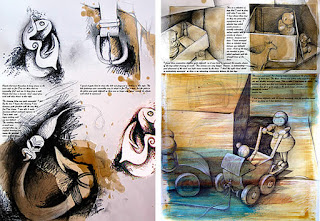Look at the following images of student's sketchbooks and consider the range of approaches and the exploration of themes. There are many different ways to approach a theme, and many layout styles, consider the one that best suits you.
Click on any of the images to enlarge them
Above all, a sketchbook should be a place for developing and refining ideas. It should show thought processes and provide insights into a student’s thinking. This sketchbook page is a helpful reminder that a Fine Art / Painting and Related Media sketchbooks need not be overly gestural or expressive: those who prefer working in a tighter, ordered, structured style should not be afraid of doing so. Indeed, such presentations can be less distracting and allow emphasis to be placed exactly where it belongs: the artwork. Here the integration of artist work, student photographs and observational drawings clearly show the journey taken while exploring and developing ideas.
Although typed annotation is not necessary or recommended, as it is too time consuming and restrictive (this was part of a digital exemplar booklet created to inspire students: annotation was thus easier to add digitally), the two International GCSE Art sketchbook page examples above show how multiple images can be combined successfully within one page. Placement of background washes, torn paper and other mixed media grounds have been positioned so that they balance each other and create an aesthetically pleasing page layout.
This sketchbook page shows the critical analysis of relevant artist work. It is important to note that it is rarely necessary to imitate an entire artist work: copying small pieces is all that is needed to learn about an artist’s technique, style, use of media or approach to composition. In this example, the composition of the page as a whole has been carefully considered: the placement of the small images on the left balance the larger portrait on the right, creating a harmonious page layout. Note also that the annotation is neat, tidy, and small. It thus supports, rather than detracts from, the artwork and indicates to the examiners that the work was produced by a committed, dedicated student
A sketchbook is the place where initial observations are recorded: there is no need for compositions to be complete or pieces finally resolved. Here we have some draw-droppingly beautiful first-hand drawings of shells using graphite and white paint on a ground of watered down acrylic.
The sketchbook is a place for essential experimentation and research: creative exploration of technique, surface and materials. These beautiful sketchbook pages by Evie have purpose and intention: exciting exploration and development.
There are so many student sketchbook pages that are filled with extravagant, over-sized headings, decorative fonts, borders and other unnecessary ornamentation: it is refreshing to see this AS Level sketchbook page by Jack Broad. Here, accurate, first-hand drawings in a range of mediums are surrounded by brief annotation. This page is a reminder of what really matters in the initial stages of a project: competent observational drawing and visual exploration of subject-matter.
Completed in the days when IGCSE Art & Design students had to submit sketchbooks (rather than the A2 preparatory sheets that are the requirement today), these two meticulously executed and skilful pages by Georgia Shattky show beautiful observational drawings completed in a range of mediums. Drawings are arranged alongside original photographs (composed and taken by Georgia), providing evidence of first-hand interaction with the subject matter.
his AS Level Art sketchbook presentation again reminds us of what the essence of a quality sketchbook should be: quality drawings (image sources clearly shown), surrounded by unobtrusive, comprehensive annotation. A simple yet striking black and white sketchbook page.
This teaching example shows clearly how an artist model is analysed, with imitations of technique leading to original works in this same style.












No comments:
Post a Comment